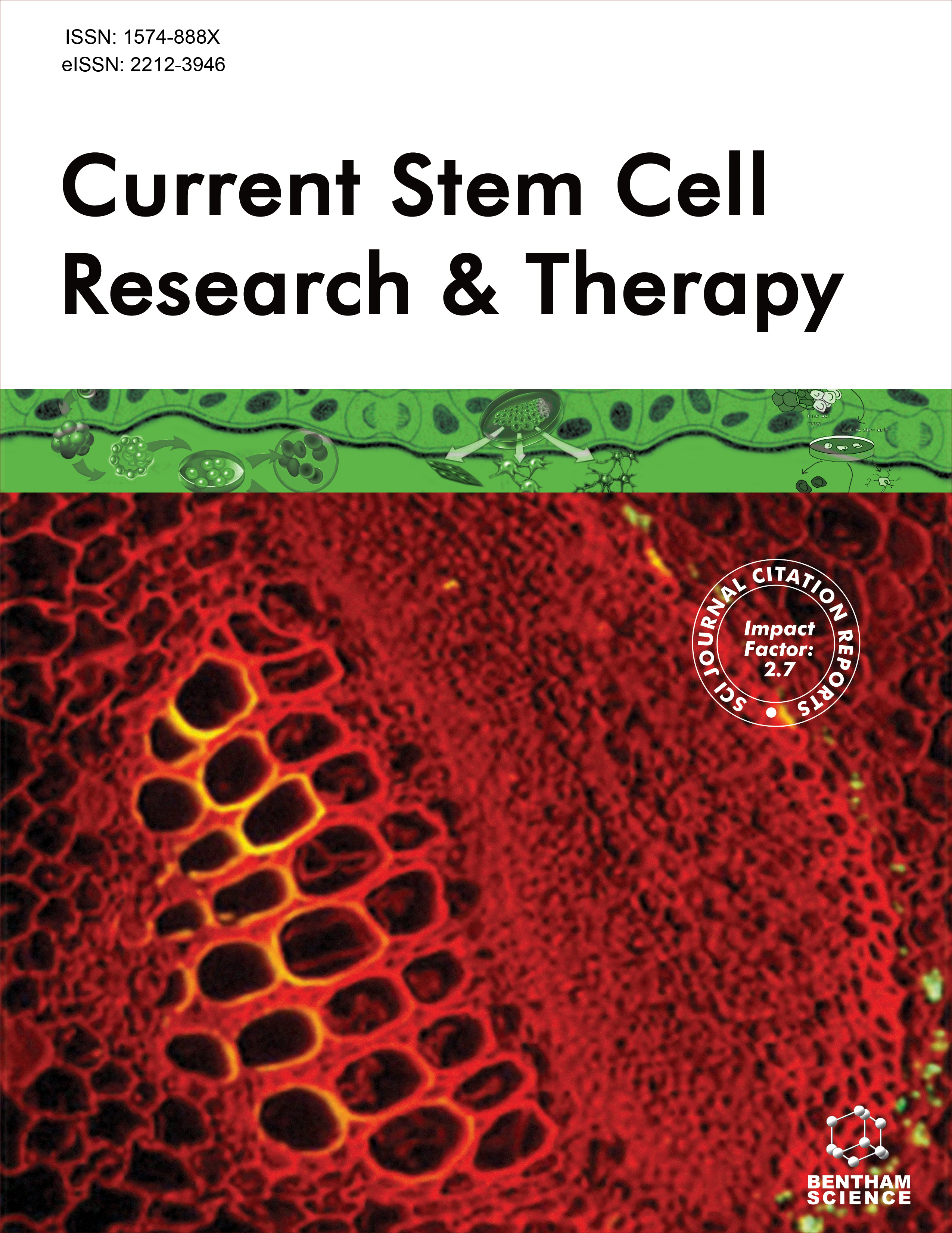- Home
- A-Z Publications
- Current Stem Cell Research & Therapy
- Previous Issues
- Volume 12, Issue 6, 2017
Current Stem Cell Research & Therapy - Volume 12, Issue 6, 2017
Volume 12, Issue 6, 2017
-
-
DNA Methylation is Correlated with Pluripotency of Stem Cells
More LessAuthors: Ruofeng Wang and Tianqing LiBackground: Pluripotency of stem cells is an important scientific issue and is attracting great interest for the broader community, especially for regenerative medicine field. Pluripotent stem cells (PSCs) in mammalians are defined as naive- and primed-states according to their cellular, molecular, epigenetic and functional states. Objective: Understand the correlation between DNA methylation and pluripotency of stem c Read More
-
-
-
Directed Differentiation and Paracrine Mechanisms of Mesenchymal Stem Cells: Potential Implications for Tendon Repair and Regeneration
More LessAuthors: Bingyu Zhang, Qing Luo, Alexander Halim, Yang Ju, Yasuyuki Morita and Guanbin SongBackground: Tendon is composed of connective tissue, is able to retract with high tensile force, and plays a significant role in musculoskeletal motion. However, inappropriate physical training or accidents often result in tendon injuries. So far, the functional healing of injured tendon is still a great challenge in orthopedics. Mesenchymal stem cells (MSCs) are multilineage cells with the ability to self-renew and differentiate into Read More
-
-
-
Tissue Elasticity Bridges Cancer Stem Cells to the Tumor Microenvironment Through microRNAs: Implications for a “Watch-and-Wait” Approach to Cancer
More LessBackground: Targeting the tumor microenvironment (TME) through which cancer stem cells (CSCs) crosstalk for cancer initiation and progression, may open new treatments different from those centered on the original hallmarks of cancer genetics thereby implying a new approach for suppression of TME driven activation of CSCs. Cancer is dynamic, heterogeneous, evolving with the TME and can be influenced by tissue Read More
-
-
-
Complications Following Stem Cell Therapy in Inflammatory Bowel Disease
More LessAuthors: Hongyun Wei, Xiaowei Liu, Chunhui Ouyang, Jie Zhang, Shuijiao Chen, Fanggen Lu and Linlin ChenBackgrounds: Pharmacotherapy and surgery constitute the mainstay of treatment for inflammatory bowel disease (IBD). But post-treatment relapsing and recurrence persist as concerns in patients with IBD. Stem cell therapy (SCT) has emerged as a promising treatment strategy in inflammatory bowel disease (IBD), including hematopoietic stem cells (HST), mensenchymal stem cells (MSCs). However, severe compli Read More
-
-
-
Significance of CD34 Negative Hematopoietic Stem Cells and CD34 Positive Mesenchymal Stem Cells – A Valuable Dimension to the Current Understanding
More LessAuthors: Chandra Viswanathan, Rohit Kulkarni, Abhijit Bopardikar and Sushilkumar RamdasiBackground: The strategy to expand CD34+ hematopoietic stem cells (HSCs) is being increasingly practiced to meet the demand for a higher cell dose. This is for hematopoietic reconstitution in patients with higher body weights. Interestingly, literature reports show that CD34- (CD34 negative) cell population also possesses the potential to reconstitute the bone marrow & in a certain phase, converts them into CD34+ phenotype. Read More
-
-
-
Cell Surface Markers on Adipose-Derived Stem Cells: A Systematic Review
More LessAuthors: Alexander Mildmay-White and Wasim KhanBackground: Since the discovery and isolation of a mesenchymal stem cell population from within the stromal vascular fraction (SVF) of adipose tissue, there has been a concerted effort to discover the characteristics of these cells. Particular attention has been paid to their morphology, selfrenewal capacity, multi-lineage differentiation capabilities and, as is of greatest interest in this instance, their cell surface profile. Obj Read More
-
-
-
From Stem Cell Biology to The Treatment of Lung Diseases
More LessAuthors: Dorina Esendagli and Aysen Gunel-OzcanBackground: The exposure of lung to noxious agents or gasses leads to injury, which further enhances repair mechanisms by promoting the proliferation and differentiation of lung stem cells. These cells could help preserve the anatomical structure and the function of the organ. Unfortunately in many lung diseases, 'this scenario' is changed and injury progresses despite repair mechanisms or conventional treatm Read More
-
-
-
Tissue Engineering in Achilles Tendon Reconstruction; The Role of Stem Cells, Growth Factors and Scaffolds
More LessAuthors: Dilip S. Pillai, Baljinder S. Dhinsa and Wasim S. KhanBackground: Achilles tendon injuries are common, and present a challenge in the acute and chronic setting. There is significant morbidity associated with the injury and the numerous management strategies, as well as financial implications to the patient and the health service. To date, repair tissue from all methods of management fail to achieve the same functional and biomechanical properties as the native tendon. O Read More
-
-
-
Adipose Tissue-Derived Pericytes for Cartilage Tissue Engineering
More LessAuthors: Jinxin Zhang, Chunyan Du, Weimin Guo, Pan Li, Shuyun Liu, Zhiguo Yuan, Jianhua Yang, Xun Sun, Heyong Yin, Quanyi Guo and Chenfu ZhouBackground: Mesenchymal stem cells (MSCs) represent a promising alternative source for cartilage tissue engineering. However, MSC culture is labor-intensive, so these cells cannot be applied immediately to regenerate cartilage for clinical purposes. Risks during the ex vivo expansion of MSCs, such as infection and immunogenicity, can be a bottleneck in their use in clinical tissue engineering. As a novel stem cell source, Read More
-
Volumes & issues
-
Volume 20 (2025)
-
Volume 19 (2024)
-
Volume 18 (2023)
-
Volume 17 (2022)
-
Volume 16 (2021)
-
Volume 15 (2020)
-
Volume 14 (2019)
-
Volume 13 (2018)
-
Volume 12 (2017)
-
Volume 11 (2016)
-
Volume 10 (2015)
-
Volume 9 (2014)
-
Volume 8 (2013)
-
Volume 7 (2012)
-
Volume 6 (2011)
-
Volume 5 (2010)
-
Volume 4 (2009)
-
Volume 3 (2008)
-
Volume 2 (2007)
-
Volume 1 (2006)
Most Read This Month
Article
content/journals/cscr
Journal
10
5
false
en


